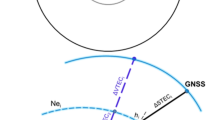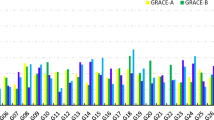Abstract
In this paper, we present an approach to generating a global topside ionospheric map (GTIM) using dual-frequency global positioning system (GPS) data from multiple low Earth orbit (LEO) satellites at different orbital altitudes. NeQuick2 is employed to normalize LEO data to the same observation range, and 13 LEO satellites from 2015/01/01 to 2015/09/27 are used to generate GTIM-500 (with an ionospheric range from 500 km to 20,200 km) and GTIM-800 (with an ionospheric range from 800 km to 20,200 km). First, we use the coinciding pierce point technique to study the error induced by altitude normalization. The results show that the relative bias error is approximately 1%. Then, the performance and accuracy of the GTIMs as well as the differential code bias (DCB) of GPS receivers onboard LEO and GPS satellites are compared and analyzed. The statistical results of the differences between the official LEO-DCB products and the LEO-DCBs estimated by our different solutions show a RMS improvement of 23% and 41% for GTIM-500 and GTIM-800, respectively. The improvement in RMS of GPS-DCBs for the proposed method is approximately 20%. Finally, the accuracy of GTIM is evaluated by the dSTEC assessment method. The results show that the RMS of GTIM-500 is 0.50 TECU (total electron content unit) for both methods. In terms of GTIM-800 estimated by the proposed method, the RMS has an improvement of 24%.















Similar content being viewed by others
References
Baarda W (1973) S-transformations and criterion matrices. In: Publications on geodesy, 18, Netherlands Geodetic Commission, Delft, The Netherland, vol 5, no 1
Bilitza D, Altadill D, Truhlik V, Shubin V, Galkin I, Reinisch B, Huang BS (2017) International Reference Ionosphere 2016: from ionospheric climate to real-time weather predictions. Space Weather 15:418–429
Buckreuss S, Werninghaus R, Pitz W (2008) The German satellite mission TerraSAR-X. In: 2008 IEEE Radar conference, p. 1–5
Chen P, Yao Y, Li Q, Yao W (2017) Modeling the plasmasphere based on LEO satellites onboard GPS measurements. Journal of Geophysical Research: Space Physics 122:1221–1233
Chen J, Ren X, Zhang X, Zhang J, Huang L (2020) Assessment and validation of three ionospheric models (IRI-2016, NeQuick2, and IGS-GIM) From 2002 to 2018. Space Weather, 18, e2019SW002422
Ciraolo L, Azpilicueta F, Brunini C, Meza A, Radicella SM (2007) Calibration errors on experimental slant total electron content (TEC) determined with GPS. J Geodesy 81:111–120
Clerbaux C, Boynard A, Clarisse L, George M, Hadji-Lazaro J, Herbin H, Hurtmans D, Pommier M, Razavi A, Turquety S, Wespes C, Coheur PF (2009) Monitoring of atmospheric composition using the thermal infrared IASI/MetOp sounder. Atmos Chem Phys 9:6041–6054
Coïsson P, Radicella SM, Leitinger R, Nava B (2006) Topside electron density in IRI and NeQuick: features and limitations. Adv Space Res 37:937–942
Darrouzet F, De Keyser J, Pierrard V (eds) (2009) The Earth’s plasmasphere: a cluster and IMAGE perspective, Springer, New York, ISBN: 978-1-4419-1322-7
Foelsche U, Kirchengast G (2002) A simple “geometric” mapping function for the hydrostatic delay at radio frequencies and assessment of its performance. Geophys Res Lett 29:111–114
Fong C-J, Yen NL, Chu C-H, Yang S-K, Shiau W-T, Huang C-Y, Chi S, Chen S-S, Liou Y-A, Kuo Y-H (2009) FORMOSAT-3/COSMIC Spacecraft Constellation System, Mission Results, and Prospect for Follow-On Mission. Terrestrial Atmospheric and Oceanic Sciences 20:1–19
Friis-Christensen E, Lühr H, Hulot G (2006) Swarm: a constellation to study the Earth’s magnetic field. Earth, Planets and Space 58:351–358
Gulyaeva T (2003) International standard model of the Earth’s inosphere and plasmasphere. Astronomical & Astrophysical Transactions 22:639–643
Hernández-Pajares M, Juan JM, Sanz J, Orus R, Garcia-Rigo A, Feltens J, Komjathy A, Schaer SC, Krankowski A (2009) The IGS VTEC maps: a reliable source of ionospheric information since 1998. J Geodesy 83:263–275. https://doi.org/10.1007/s00190-008-0266-1
Hernández-Pajares M, Roma-Dollase D, Krankowski A, García-Rigo A, Orús-Pérez R (2017) Methodology and consistency of slant and vertical assessments for ionospheric electron content models. J Geodesy 91:1405–1414
Hwang C, Tseng T-P, Lin T-J, Švehla D, Hugentobler U, Chao BF (2010) Quality assessment of FORMOSAT-3/COSMIC and GRACE GPS observables: analysis of multipath, ionospheric delay and phase residual in orbit determination. GPS Solutions 14:121–131
Lee S (2010) Overview of KOMPSAT-5 program, mission, and system. In: 2010 IEEE international geoscience and remote sensing symposium, pp 797–800
Lemaire J, Gringauz KI (1998) The Earth’s plasmapause. Cambridge University Press, New York
Li Z, Yuan Y, Fan L, Huo X, Hsu H (2013) Determination of the differential code bias for current BDS satellites. IEEE Trans Geosci Remote Sens 52(7):3968–3979
Li Z, Wang N, Hernández-Pajares M et al (2020) IGS real-time service for global ionospheric total electron content modeling. J Geodesy 94:32
Lin J, Yue X, Zhao S (2016) Estimation and analysis of GPS satellite DCB based on LEO observations. GPS Solutions 20:251–258
Liu A, Wang N, Li Z, Wang Z, Yuan H (2019) Assessment of NeQuick and IRI-2016 models during different geomagnetic activities in global scale: comparison with GPS-TEC, dSTEC, Jason-TEC and GIM. Adv Space Res 63:3978–3992
Mannucci AJ, Wilson BD, Yuan DN, Ho CH, Lindqwister UJ, Runge TF (1998) A global mapping technique for GPS-derived ionospheric total electron content measurements. Radio Science 33:565–582
Montenbruck O, Kroes R (2003) In-flight performance analysis of the champ blackjack gps receiver. GPS Solutions 7(2):74–86
Montenbruck O, Hauschild A, Steigenberger P (2014) Differential code bias estimation using multi-GNSS observations and global ionosphere maps. Navig J Inst Navig 61(3):191–201
Nava B, Coïsson P, Radicella SM (2008) A new version of the NeQuick ionosphere electron density model. J Atmos Solar Terr Phys 70:1856–1862
Odijk D, Zhang B, Khodabandeh A, Odolinski R, Teunissen PJ (2016) On the estimability of parameters in undifferenced, uncombined GN network and PPP-RTK user models by means of S-system theory. J Geod 90(1):15–44
Orús R, Hernández-Pajares M, Juan JM, Sanz J (2005) Improvement of global ionospheric VTEC maps by using kriging interpolation technique. J Atmos Solar Terr Phys 67:1598–1609
Ren X, Zhang X, Xie W, Zhang K, Yuan Y, Li X (2016) Global Ionospheric Modelling using Multi-GNSS: BeiDou, Galileo. GLONASS and GPS. Scientific Reports 6:33499
Ren X, Chen J, Li X, Zhang X, Freeshah M (2019) Performance evaluation of real-time global ionospheric maps provided by different IGS analysis centers. GPS Solutions 23:113
Ren X, Chen J, Li X, Zhang X (2020) Multi-GNSS contributions to differential code biases determination and regional ionospheric modelling in China. Adv Space Res 65:221–234
Rich FJ, Sultan PJ, Burke WJ (2003) The 27-day variations of plasma densities and temperatures in the topside ionosphere. J Geophys Res Space Phys 108:1297
Rideout W, Coster A (2006) Automated GPS processing for global total electron content data. GPS Solutions 10:219–228
Roma-Dollase D, Hernández-Pajares M, Krankowski A et al (2018) Consistency of seven different GNSS global ionospheric mapping techniques during one solar cycle. J Geodesy 92(6):691–706
Schaer S (1999) Mapping and predicting the Earth’s ionosphere using the global positioning system. Ph.D. dissertation, University of Bern, Bern
Schunk RW, Sojka JJ (1992) Approaches to ionospheric modelling, simulation and prediction. Adv Space Res 12:317–326
Singh N, Horwitz JL (1992) Plasmasphere refilling: recent observations and modelling. J Geophys Res 97:1049–1079
Tapley BD, Bettadpur S, Ries JC, Thompson PF, Watkins MM (2004) GRACE measurements of mass variability in the Earth system. Science 305:503–505
Teunissen PJG (1985) Generalized inverses, adjustment, the datum problem and S-transformations. In: Sanso F, Grafarend EW (eds) Optimization of geodetic networks. Springer-Verlag, Berlin, pp 11–55
Torr MR, Torr DG, Richards PG, Yung SP (1990) Mid- and low-latitude model of thermospheric emissions 1 O + (2P) 7320 A and N2 (2P) 3371 A. J Geophys Res 95:21147–21168
Wang N, Yuan Y, Li Z, Montenbruck O, Tan B (2016) Determination of differential code biases with multi-GNSS observations. J Geodesy 90:209–228
Xiang Y, Gao Y, Shi J, Xu C (2019) Consistency and analysis of ionospheric observables obtained from three precise point positioning models. J Geod 93:1161–1170
Yue X, Schreiner WS, Hunt DC, Rocken C, Kuo Y-H (2011) Quantitative evaluation of the low Earth orbit satellite based slant total electron content determination. Space Weather. https://doi.org/10.1029/2011SW000687
Zhang X, Tang L (2014) Daily global plasmaspheric maps derived from COSMIC GPS observations. IEEE Trans Geosci Remote Sens 52:6040–6046
Zhong J, Lei J, Dou X, Yue X (2016) Assessment of vertical TEC mapping functions for space-based GNSS observations. GPS Solut 20:353–362
Acknowledgements
This research was funded by the National Science Fund for Distinguished Young Scholars (Grant no. 41825009) provided by Xiaohong Zhang, Changjiang Scholars program provided by Xiaohong Zhang; National Natural Science Foundation of China (no. 41904026) provided by Xiaodong Ren, the Funds for Creative Research Groups of China (no. 41721003) provided by Xiaohong Zhang. The numerical calculations have been done on the supercomputing system in the Supercomputing Center of Wuhan University. We thank all anonymous reviewers for their valuable, constructive, and prompt comments. We are very grateful to the Ionosphere Radiopropagation Unit of the T/ICT4D Laboratory for providing the NeQuick2 model code via https://t-ict4d.ictp.it/nequick2/source-code, ESA for providing the Swarm relevant data via ftp://swarm-diss.eo.esa.int, CDAAC for providing relevant data of the other LEO satellites via https://cdaac-www.cosmic.ucar.edu/cdaac/products.html, and the Crustal Dynamics Data Information System (CDDIS) data center for providing navigation file by the following FTP server: ftp://cddis.gsfc.nasa.gov/pub/gps/data/daily/.
Author information
Authors and Affiliations
Contributions
XR, XZ and MS designed the research; XR and JC performed the research and wrote the paper; XR, JC, and JZ analyzed the data; XZ, XL, and MS gave helpful discussions on additional analyses and result interpretation.
Corresponding author
Rights and permissions
About this article
Cite this article
Ren, X., Chen, J., Zhang, X. et al. Mapping topside ionospheric vertical electron content from multiple LEO satellites at different orbital altitudes. J Geod 94, 86 (2020). https://doi.org/10.1007/s00190-020-01415-2
Received:
Accepted:
Published:
DOI: https://doi.org/10.1007/s00190-020-01415-2




